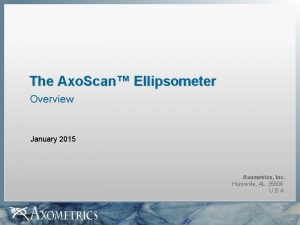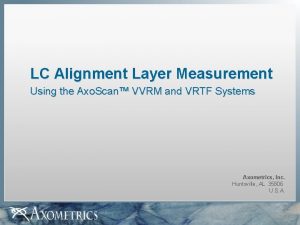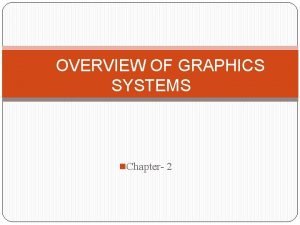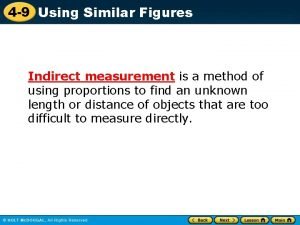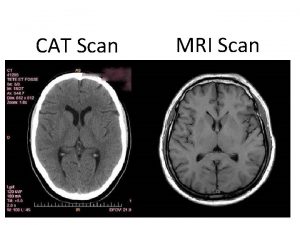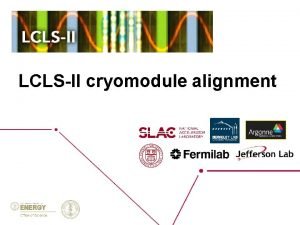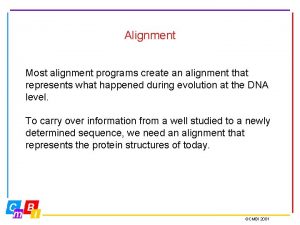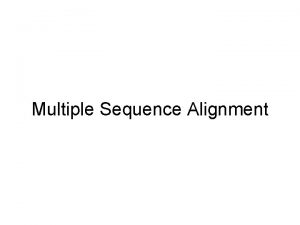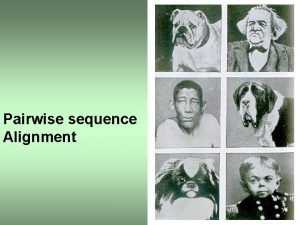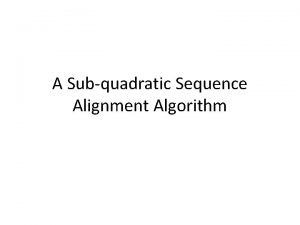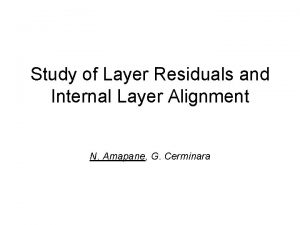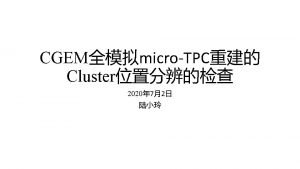LC Alignment Layer Measurement Using the Axo Scan










































- Slides: 42

LC Alignment Layer Measurement Using the Axo. Scan™ VVRM and VRTF Systems Axometrics, Inc. Huntsville, AL 35806 U. S. A.

Axometrics § Founded in 2002 § Huntsville, Alabama, U. S. A § A world leader in polarized light optical measurement systems § Primary focus is the LCD industry § Hundreds of systems shipped throughout Asia

Contents § Basic Overview of PI Testing § The Axo. Scan System § Analysis Methods § Ellipsometry § Generalized Ellipsometry § Fast Mueller Matrix Method § Sample Data § Lab Systems and Production Systems CONFIDENTIAL

LC Alignment Layer Measurements § Use the Axo. Scan™ system for testing LC alignment layers § Layer types § PI (isotropic) § Rubbed PI § Photo-aligned PI (PAPI) § Measurement parameters: § Film thickness § Alignment direction § Alignment strength (anisotropy) § Tilt angle CONFIDENTIAL

PI Film Testing § Polyimide (PI) film on bare glass § Before photo-alignment or rubbing, PI is isotropic § Isotropic means the refractive index n is the same in all directions § Axo. Scan will measure thickness t and refractive index n of the PI film CONFIDENTIAL

Anisotropy § When PI is photo-aligned or rubbed, it becomes anisotropic Large Δn High exposure strength Strong anchoring energy Increasing exposure energy § Refractive index n is different depending on direction § Δn = nmax - nmin § The anisotropy, Δn, is proportional to the photo-alignment exposure strength (or rubbing strength) and azimuthal anchoring energy Small Δn Low exposure strength Weak anchoring energy CONFIDENTIAL

Anisotropy Orientation § An anisotropic film will have a its maximum refractive index, nmax, aligned in some direction, θ § The anisotropy orientation, θ, is proportional to the photoalignment polarizer angle (or rubbing direction) § LC molecules will align in this direction s tion a ction c e r i d re ame nment di s e h lig In t oto-a rection h p e i th ing d b b u or r CONFIDENTIAL

Anisotropy Tilt Angle § For photo-aligned PI, the anisotropy tends to lay flat § LC molecules will have 0° pretilt angle § For rubbed PI, the anisotropy can be tilted up (away from the glass) by an angle Φ Photo-aligned PI usually has no tilt angle § This is will cause LC molecules to have a pre-tilt angle > 0° Rubbed PI has a tilt angle Φ CONFIDENTIAL

Complex Refractive Index § Real part n describes how fast light moves through the material. Usually just called the “refractive index”. Imaginary part k describes how light is absorbed by the material. If k = 0, the material is perfectly clear. Sometimes k is called the “absorption coefficient”. CONFIDENTIAL

Complex Refractive Index – Cont. § CONFIDENTIAL

Two Analysis Methods § Two different analysis methods depending on the sample type: § Generalized Ellipsometry (GE) § Industry-standard technique for characterizing anisotropic thin films § Actual measurement of thickness, anisotropy, orientation, and tilt § Can be used when the layer structure is simple and uniform § This is the preferred technique § Fast Mueller Matrix Method (FMMM) § Developed by Axometrics (Patent Pending) § Actual measurement of orientation, relative measurement of orientation and tilt § Can be used on complex and pixelated layers § Axo. Scan performs GE and FMMM at the same speed! CONFIDENTIAL

Sample Types PI on dummy glass, or on areas between cells PI on CF glass active area PI on TFT glass active area with planarization layer CONFIDENTIAL

Axo. Scan Capabilities § Measurement performance depends strongly on sample type § Pixel geometry, PI material, exposure / rubbing strength, etc. § See the following are guidelines. Note that testing on actual customer samples is always recommended. CONFIDENTIAL

Typical Specifications § Typical measurement specification in cases where excellent performance can be achieve: § Measurement time: 30 s § Thickness: 3σ = 0. 1 nm § Anisotropy: 3σ = 0. 5% CV § Anisotropy orientation: 3σ = 0. 1° § Measurement performance is strongly affected by factors including pixel geometry, PI material, exposure / rubbing strength, etc. § Please consider sending samples to Axometrics for testing CONFIDENTIAL

Contents § Basic Overview of PI Testing § The Axo. Scan System § Analysis Methods § Ellipsometry § Generalized Ellipsometry § Fast Mueller Matrix Method § Sample Data § Lab Systems and Production Systems CONFIDENTIAL

Axo. Scan-HSO § System uses the Axo. Scan sensor for the high-sensitivity option (HSO) § Uses photo-multiplier tube detection due to low light level from glass reflection CONFIDENTIAL

Polarization State Possibilities § Polarization state of light can be an arbitrary ellipse § Circular right-hand rotation § Elliptical § Linear § Clockwise rotation § Right-handed § Counterclockwise rotation linear § Left-handed left-hand rotation CONFIDENTIAL

Axo. Scan Sensor Theory § Test the sample with 120 different polarization states in 30 ms § All types of states: § Linear polarization, Elliptical polarization, Left-Handed and Right-Handed CONFIDENTIAL

Axo. Scan Sensor Theory – Continued § Fixed polarizer followed by a rotating retarder generates these polarization states: § A rotating retarder followed by a fixed polarizer analyzes states after the sample § Analyzer retarder rotates five times faster than the generator. § Provides a sufficient variety polarization states to calculate the Mueller matrix CONFIDENTIAL 19

Axo. Scan Sensor Theory – Continued § Mathematics for calculating the Mueller matrix: 1. Creates N polarization states with a known Stokes vector Sn 2. Each Sn interacts with the unknown Mueller matrix M 3. Then they interact with known Stokes vector An of the analyzer 4. Then measure the intensity Pn for each of the n states § Each measured intensity is defined by the dot product: Pn = (An)T·M·Sn § Use linear algebra technique (matrix pseudo-inverse) to find M § Full details can be found here: R. A. Chipman, Polarimetry, Ch. 22 in Handbook of Optics Vol. II, 2 nd Ed. , M. Bass ed. , Mc. Graw-Hill, New York, 1995. CONFIDENTIAL

Measurement Technique § Typical measurement recipe: § Measure the Mueller matrix § Rotate the sample by 20° and measure the Mueller matrix again § Repeat 19 times until reaching full 360° rotation § Perform either GE or FMMM analysis § Requires 30 seconds CONFIDENTIAL

Tunable Visible Source § Tune any wavelength 400 ~ 800 nm. Important if samples have multiple layers § Incoherent (non-laser) light removes interference problems CONFIDENTIAL

Spot Size § Axo. Scan uses either 3 mm optical beam standard § Average value of several pixels § No focusing needed § No precision alignment needed § Using incoherent light source (not laser) reduces problems with interference fringes and diffraction § Other spot sizes: § 1 mm spot is available as an option § Variable spot size down to 100 µm is available as an option CONFIDENTIAL

System Configurations § Axo. Scan VRTM § Axo. Scan VVRM § Desktop system § Measurement head rotation § Sample stage rotation § Large sample sizes possible § Up to 6 -inch (150 mm) samples § 20”, 42”, 65”, … § Gen 4, Gen 5, Gen 6, … CONFIDENTIAL

Tact Time § No time to focus or re-center between measurements is needed § Typical tact time chart for 9 measurement locations: CONFIDENTIAL

Contents § Basic Overview of PI Testing § The Axo. Scan System § Analysis Methods § Ellipsometry § Generalized Ellipsometry § Fast Mueller Matrix Method § Sample Data § Lab Systems and Production Systems CONFIDENTIAL

Ellipsometry § Polarization of light changes when reflected from thin films on sample § Complicated equations describe how the polarization changes due to thickness (t) and refractive index (n and k) of each thin film layer § By measuring the polarization change, we can calculate t, n, and k of each layer CONFIDENTIAL

Generalized Ellipsometry § Regular ellipsometry requires the sample layers to be isotropic § But photo-aligned or rubbed PI are anisotropic § Generalized Ellipsometry (GE) is an extension of standard ellipsometry that allows for anisotropic layers § GE requires a more complicated polarization measurement § This is no problem for Axo. Scan since the full Mueller matrix is acquired in 30 ms. CONFIDENTIAL

Fast Mueller Matrix Method § Generalized Ellipsometry (GE) is the preferred measurement § Axo. Scan make full GE measurements as fast as other company’s simple measurement technique! § So GE is always possible on dummy glass § But sometimes the GE method is very difficult: § If layers structure is too thick or too complicated § If sample is patterned (like TFT or CF active area) § In those cases, Axometrics created the Fast Mueller Matrix Method (FMMM) CONFIDENTIAL

Fast Mueller Matrix Method – Cont. § If you rotate the isotropic sample, the reflected polarization signal always remains parallel to the glass (0°) CONFIDENTIAL

Fast Mueller Matrix Method – Cont. § But for an anisotropic sample, the polarization signal will change when the sample is rotated CONFIDENTIAL

Fast Mueller Matrix Method – Cont. § Use Diattenuation Orientation (θψ)/Retardance (δ) vs. Rotation Angle § “Which input polarization state has maximum reflectivity/phase shift? ” § Reflection from air-PI interface dominates measurement § Not strongly affected by other thin-films and active area CONFIDENTIAL

Fast Mueller Matrix Method – Cont. § CONFIDENTIAL

Key Advantage § Axo. Scan make full ellipsometry measurements as fast as other company’s simple measurement technique CONFIDENTIAL

Contents § Basic Overview of PI Testing § The Axo. Scan System § Analysis Methods § Ellipsometry § Generalized Ellipsometry § Fast Mueller Matrix Method § Sample Data § Lab Systems and Production Systems CONFIDENTIAL

Photo-Aligned PI on Dummy Glass § See that Δn and Δk do not vary linearly with exposure energy! § This is only true for some types of PI material § But total anisotropy is a good indicator of exposure energy § Analysis by GE method is absolutely needed for this sample! CONFIDENTIAL

Photo-Aligned PI on TFT Glass § Relative anisotropy measurements of photo-aligned PI on production panel TFT glass § Analyzed by FMMM CONFIDENTIAL

Relative Anisotropy of Rubbed PI § Rubbed PI on production panel, CF glass § Measurement of relative anisotropy for different rubbing conditions Rubbing parameters Relative Anisotropy Stage Speed 15 0. 62 Stage Speed 25 0. 53 Mark Width 13. 5 0. 32 Mark Width 17. 5 0. 69 RPM 1200 0. 59 RPM 1600 0. 82 Higher stage speed, Larger Anisotropy Wider mark, Larger Anisotropy Higher roller speed, Larger Anisotropy CONFIDENTIAL

High-Resolution Photo-Aligned PI Test § Production CF glass, FMMM test § Scan across 3 cells on a motherglass § Traverse direction § Notice the 0. 3° change in orientation in the transition region

Contents § Basic Overview of PI Testing § The Axo. Scan System § Analysis Methods § Ellipsometry § Generalized Ellipsometry § Fast Mueller Matrix Method § Sample Data § Lab Systems and Production Systems CONFIDENTIAL

VRTF-1 Lab System § Lab system for samples up to 6” CONFIDENTIAL

VVRM § Systems for testing mother glass or cut cells § G 4. 5 § G 5. 5 § G 6 § Offline in inline operation CONFIDENTIAL
 Axo scan
Axo scan Axo scan
Axo scan Compare two sequences
Compare two sequences Pam1250
Pam1250 Sequence alignment
Sequence alignment Bioinformatics sequence alignment
Bioinformatics sequence alignment Jonathan pevsner
Jonathan pevsner Kahoot pin
Kahoot pin Raster scan system in computer graphics
Raster scan system in computer graphics Cathode ray tube in computer graphics
Cathode ray tube in computer graphics Raster scan is more expensive than random scan
Raster scan is more expensive than random scan Fig 19
Fig 19 Parietal layer and visceral layer
Parietal layer and visceral layer Secure socket layer and transport layer security
Secure socket layer and transport layer security Layer 6 presentation layer
Layer 6 presentation layer Secure socket layer and transport layer security
Secure socket layer and transport layer security Secure socket layer and transport layer security
Secure socket layer and transport layer security Secure socket layer and transport layer security
Secure socket layer and transport layer security Layer 2 e layer 3
Layer 2 e layer 3 Layer-by-layer assembly
Layer-by-layer assembly Layer 2 vs layer 3 bitstream
Layer 2 vs layer 3 bitstream Similar figures and indirect measurement
Similar figures and indirect measurement Hát kết hợp bộ gõ cơ thể
Hát kết hợp bộ gõ cơ thể Frameset trong html5
Frameset trong html5 Bổ thể
Bổ thể Tỉ lệ cơ thể trẻ em
Tỉ lệ cơ thể trẻ em Gấu đi như thế nào
Gấu đi như thế nào Glasgow thang điểm
Glasgow thang điểm Hát lên người ơi alleluia
Hát lên người ơi alleluia Môn thể thao bắt đầu bằng từ chạy
Môn thể thao bắt đầu bằng từ chạy Thế nào là hệ số cao nhất
Thế nào là hệ số cao nhất Các châu lục và đại dương trên thế giới
Các châu lục và đại dương trên thế giới Công của trọng lực
Công của trọng lực Trời xanh đây là của chúng ta thể thơ
Trời xanh đây là của chúng ta thể thơ Mật thư anh em như thể tay chân
Mật thư anh em như thể tay chân Làm thế nào để 102-1=99
Làm thế nào để 102-1=99 Phản ứng thế ankan
Phản ứng thế ankan Các châu lục và đại dương trên thế giới
Các châu lục và đại dương trên thế giới Thơ thất ngôn tứ tuyệt đường luật
Thơ thất ngôn tứ tuyệt đường luật Quá trình desamine hóa có thể tạo ra
Quá trình desamine hóa có thể tạo ra Một số thể thơ truyền thống
Một số thể thơ truyền thống Bàn tay mà dây bẩn
Bàn tay mà dây bẩn Vẽ hình chiếu vuông góc của vật thể sau
Vẽ hình chiếu vuông góc của vật thể sau
